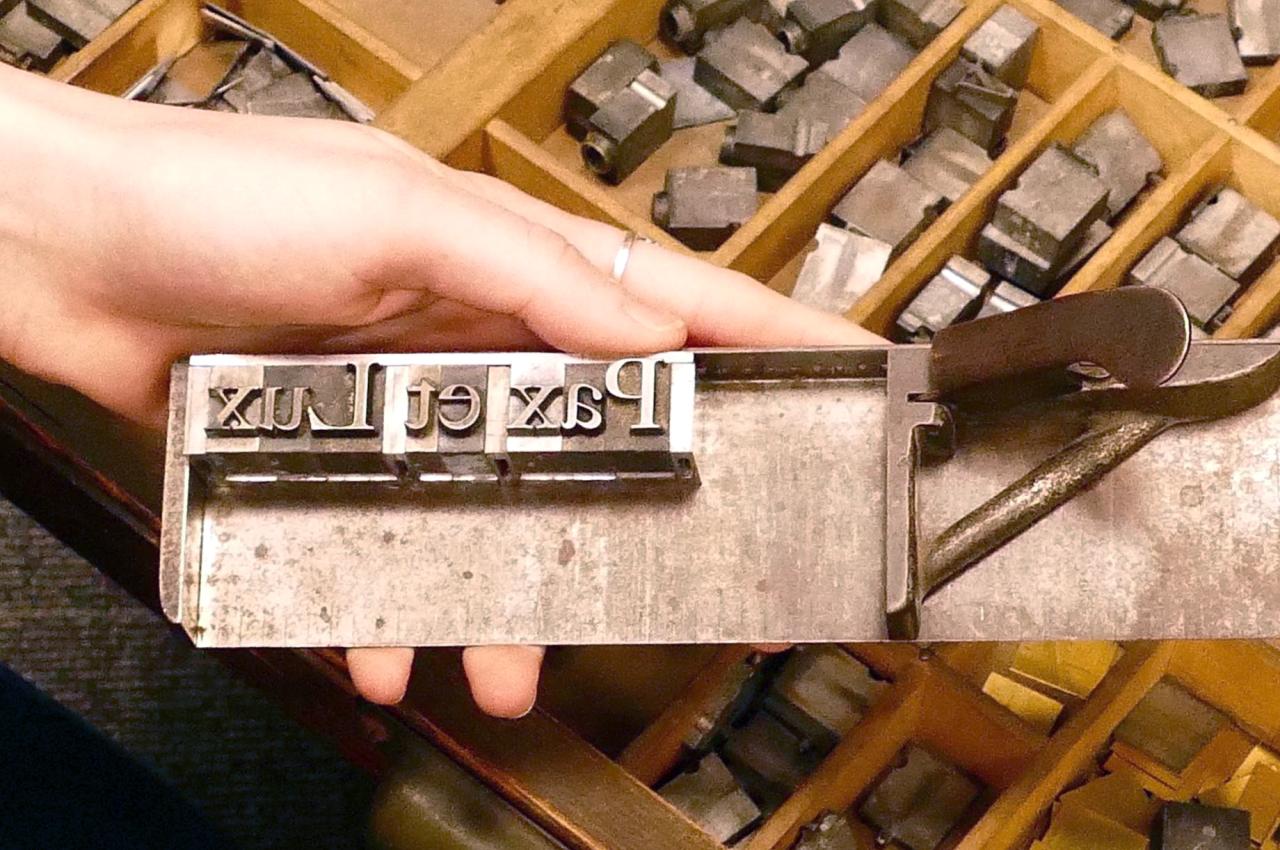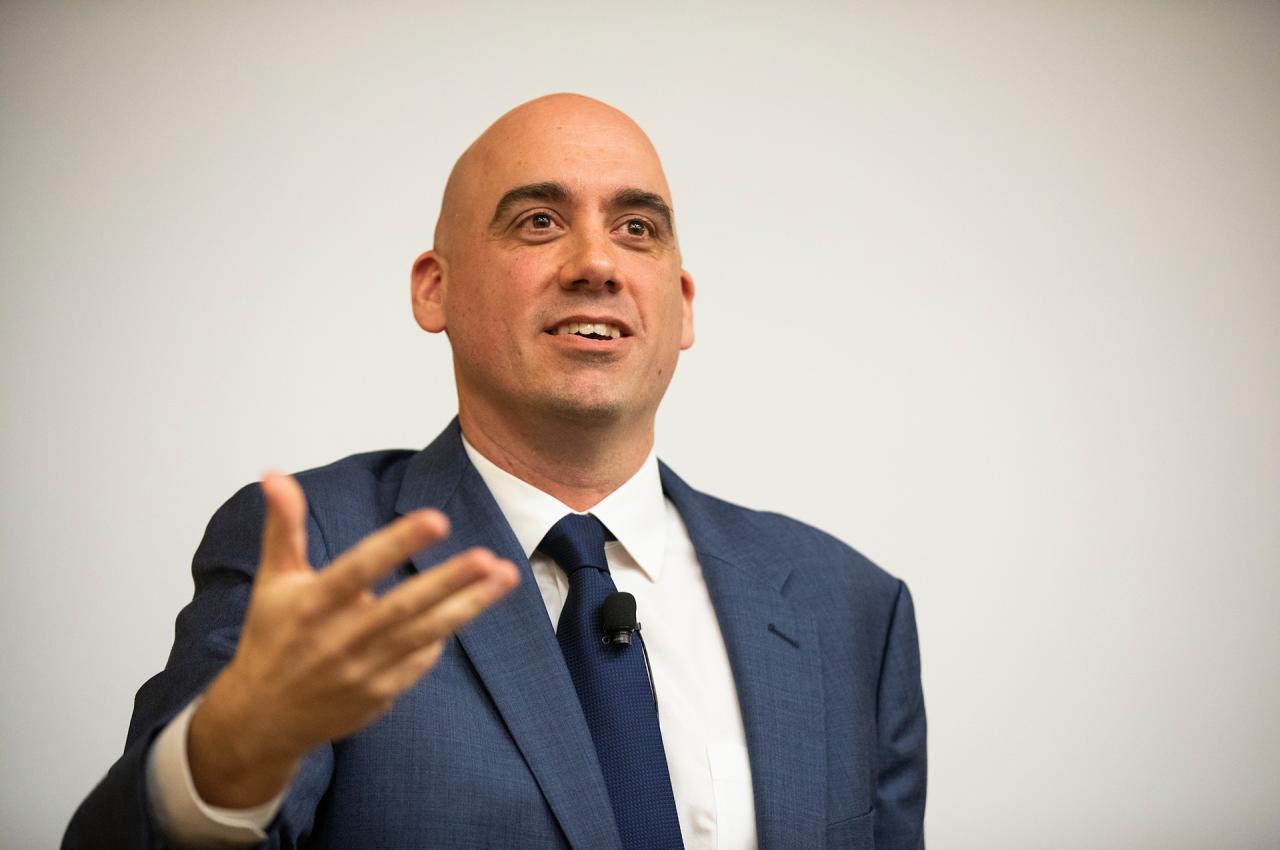Vintage Letterpress Offers Opportunities to Learn “through the Hands”
Chances are the vintage letterpress now at Tufts had a productive, even colorful, past. In its heyday—the 1960s and early 1970s—it was probably busy printing showcards, advertisements that department stores and shops displayed to pitch their wares.
Now a different future is unfolding in the letterpress’s new home in Tisch Library’s Special Collections.
Weighing in at two hundred pounds and yet compact enough to fit on a small table, the letterpress can produce pieces measuring up to 14 by 23 inches.
A form of relief printing, the letterpress process involves securing raised type on the printer’s bed. Ink is applied with a brayer, and paper positioned on top of the inked surface. The operator pulls a weighted cylinder with a hard rubber cover forward over the bed, pressing paper against the type, and transferring the text to the paper.
For Chris Barbour, head of the collections, that centuries-old process gains a new resonance within a university community. The academic setting of Special Collections frames the letterpress’s kinship with the library’s rare texts, all of which were made by letterpress printing process, going back to its origin in the 15th century.
A recent Special Collections exhibit, “Early-Modern Printer Devices,” highlighted the enduring legacy of letterpress printing. Above, a 1508 printer's device for Prelum Ascensianum ("Press of Ascensius") illlustrates press operations in the influential printing house of Josse Bade. Image courtesy of Tufts Special Collections
Within that historical context, Barbour foresees a synthesis of scholarship with learning the art of letterpress printing. Composing type on the letterpress can offer insights into how books were made and seed the imagination of aspiring artists.
“In establishing the letterpress in Tisch Special Collections, we aim to expand the opportunities for experiential learning that are central to our work,” he said.
That mission, he expanded, is best expressed by a quote from woodworker Doug Stowe: “Without the opportunity to learn through the hands, the world remains abstract, and distant, and the passions for learning will not be engaged.”
“That quote has inspired me ever since I read it,” Barbour said. “That’s what we do with books here. We want to foster learning through the hands. The letterpress is an extension of that philosophy.”
One student poised to activate that philosophy is Avery Westhagen, A26, an art history and fine art undergraduate in the five-year Arts and Sciences/School of the Museum of Fine Arts program. Shortly after the letterpress arrived in December, Barbour brought her on board to help teach Tufts students and faculty how to use it.
The timing is fortuitous. Letterpress printing, made obsolete in the 1970s by more cost-efficient offset lithography and, later, digital printing, today enjoys a renaissance among both amateur and professional artists, craft printers, and graphic designers. Compared to mass-produced printed materials, pieces created with a letterpress are imbued with greater texture and originality.
Avery Westhagen, A26, selects metal Caslon type from a typesetting cabinet that will support letterpress activities and related scholarship at Tufts. Photo: Laura Ferguson
Westhagen, a printmaker and creator of artist books, is looking forward to integrating the craft of letterpress printing into her own work.
“I would love to use the letterpress when I create my future books,” she said.
Her classmates share her enthusiasm, she said. “When I talk about the letterpress I hear, ‘Oh, I would love to try it out!’” Letterpress art books in the SMFA library are prized for their artistry and beauty, she said. “They give us ideas for what is possible.”
The letterpress may also inspire scholars using the Special Collections, which include diverse original texts set in a rich variety of typesetting formats.
The appreciation of historical forms of typesetting can remain remote and abstract without hands-on experience with the process, Barbour said. When given the chance to work through the many stages of composing text, students of rare books “gain a concrete impression of the required and exacting skill, and how precarious typesetting can be."
Barbour has found that many Tufts students share his fascination with the centuries-old art of printing. A 2023 open house at Special Collections included a chance to learn how to print with Japanese barens, traditional disc-shaped tools used in woodblock printing. Students printed with woodblocks created by Mike Smoot, SMFA professor of the practice.
“We taped a sign on the door, and really didn’t know if anyone would show up,” Barbour said. He need not have worried. “We had a line for most of the three hours during that open house.”
That response helped inspire his search for a letterpress for Tufts.
At the Museum of Printing in Haverhill, Massachusetts, where Barbour took an introductory letterpress workshop, instructor Mitchel Ahern, the museum’s director of development, suggested a showcard printer. The press’s basic design is good for beginners and provides room to increase one’s skills.
Westhagen positions paper over type to demonstrate the simple process of printing with Tufts’ vintage letterpress, which has found a new home, and future, in Tisch Library’s Special Collections.
Photo: Laura Ferguson
“In terms of techniques, the bar is relatively low,” Ahern said. “You can do sophisticated things, but you can also jump right in and have real fun.”
Barbour’s quest then led him to Chicopee, Massachusetts, where John Barrett has run Letterpress Things for some five decades. The business is a vast storehouse of letterpress tools, equipment, and supplies,
Among all the letterpresses available there, Barrett and Barbour landed on the Showcard Model B, manufactured by Vandercook & Sons in Chicago, probably in the 1960s.
The model “is perfect for a campus community,” said Barrett; students can easily master the stages of production. ‘It’s very simple and has a great safety record.”
Barbour is just at the beginning of developing ideas for the letterpress, including training and workshops, and outreach that invites faculty to consider incorporating it into course design.
For now, Westhagen is well on her way to being a thoughtful teacher.
“The spacing of the type on the paper is actually the hardest thing to get right,” she said. “It involves a lot of measuring before you even print. I haven't gotten the science down perfectly, but I'm working at it.”
For a demonstration, she peruses the cases (source of the terms “upper” and “lower case”) of the wooden type cabinet that commands a corner of Special Collections. The cabinet, most likely dating to the late 1800s, had been donated to the Museum of Printing, where Barbour purchased it and hundreds of pieces of metal Caslon type.
Westhagen’s choice of composition: Tufts motto Pax & Lux, Peace and Light. Once she has locked the type firmly in place on the printer bed, she inks the raised type with a brayer. She then positioned her paper and pulls the cylinder carriage over the raised type.
“That was pretty clean,” she said, assessing the impression, assertive in deep blue ink. Still, she mused that maybe it could be a tad sharper.
“There might have been a little too much ink,” she said. “It’s all about figuring it out and changing small things until you’re satisfied. But that‘s what is great about letterpress: You can just ink up again and keep trying.”
Latest Tufts Now
- The Art in the Archive: Sourcing Black History and Heritage at TuftsSMFA at Tufts student Julie Francois discusses her search through archival materials that illustrate the Black experience on the Hill across the years
- School of Arts and Sciences Interim Dean NamedDean of the Graduate School of Arts and Sciences Bárbara Brizuela to step into the role on July 1
- Brian Schaffner Named a 2024 Andrew Carnegie FellowThe political scientist will research a book about partisan polarization and seek a path to bridge the divide
- Who Are the Immigrants Coming to the U.S. on Humanitarian Grounds, and How Can They Be Supported?Refugees and asylum-seekers fleeing violence and persecution can adapt more quickly with support of their diaspora communities, says expert
- I Never Wanted a Dog—Certainly Not One that Bit PeopleSomehow, I found myself spending an hour a day in the woods with a rescue animal that had attacked my sons. Would this end well?
- Tufts Awards 35 Grants to Support Local InitiativesNine organizations receiving funding this year are first-time Tufts Community Grant recipients













